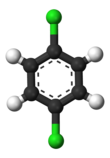| |||
 1,4-dichlorobenzene crystallised on paper from DCM solution
| |||
| Names | |||
|---|---|---|---|
| Preferred IUPAC name
1,4-Dichlorobenzene | |||
| Other names
1,4-DCB
para-Dichlorobenzene p-Dichlorobenzene p-DCB PDCB Paramoth Para crystals Paracide Dichlorocide | |||
| Identifiers | |||
3D model (JSmol)
|
|||
| 1680023 | |||
| ChEBI | |||
| ChEMBL | |||
| ChemSpider | |||
| ECHA InfoCard | 100.003.092 | ||
| EC Number |
| ||
| 49722 | |||
| KEGG | |||
PubChem CID
|
|||
| RTECS number |
| ||
| UNII | |||
| UN number | 3077 | ||
CompTox Dashboard (EPA)
|
|||
| |||
| |||
| Properties | |||
| C6H4Cl2 | |||
| Molar mass | 147.00 g·mol−1 | ||
| Appearance | Colorless/white crystals[1] | ||
| Odor | mothball-like[1] | ||
| Density | 1.25 g/cm3, solid | ||
| Melting point | 53.5 °C (128.3 °F; 326.6 K) | ||
| Boiling point | 174 °C (345 °F; 447 K) | ||
| 10.5 mg/100 mL (20 °C) | |||
| Vapor pressure | 1.3 mmHg (20 °C)[1] | ||
| -82.93·10−6 cm3/mol | |||
| Hazards | |||
| Occupational safety and health (OHS/OSH): | |||
Main hazards
|
Suspected carcinogen | ||
| GHS labelling: | |||
  
| |||
| Warning | |||
| H302, H315, H317, H319, H332, H335, H351, H410 | |||
| P201, P202, P261, P264, P270, P271, P272, P273, P280, P281, P301+P312, P302+P352, P304+P312, P304+P340, P305+P351+P338, P308+P313, P312, P321, P330, P332+P313, P333+P313, P337+P313, P362, P363, P391, P403+P233, P405, P501 | |||
| NFPA 704 (fire diamond) | |||
| Flash point | 66 °C (151 °F; 339 K) | ||
| Explosive limits | 2.5%-?[1] | ||
| Lethal dose or concentration (LD, LC): | |||
LD50 (median dose)
|
500 mg/kg (rat, oral) 2950 mg/kg (mouse, oral) 2512 mg/kg (rat, oral) 2830 mg/kg (rabbit, oral)[2] | ||
LDLo (lowest published)
|
857 mg/kg (human, oral) 4000 mg/kg (rat, oral) 2800 mg/kg (guinea pig, oral)[2] | ||
| NIOSH (US health exposure limits): | |||
PEL (Permissible)
|
TWA 75 ppm (450 mg/m3)[1] | ||
REL (Recommended)
|
Ca[1] | ||
IDLH (Immediate danger)
|
Ca [150 ppm][1] | ||
| Related compounds | |||
Related compounds
|
1,2-Dichlorobenzene 1,3-Dichlorobenzene | ||
Except where otherwise noted, data are given for materials in their standard state (at 25 °C [77 °F], 100 kPa).
| |||
1,4-Dichlorobenzene (1,4-DCB, p-DCB, or para-dichlorobenzene, sometimes abbreviated as PDCB or para) is an aryl chloride and isomer of dichlorobenzene with the formula C6H4Cl2. This colorless solid has a strong odor. The molecule consists of a benzene ring with two chlorine atoms (replacing hydrogen atoms) on opposing sites of the ring.
It is used as a disinfectant, pesticide, and deodorant, most familiarly in mothballs in which it is a replacement for the more traditional naphthalene because of naphthalene's greater flammability (though both chemicals have the same NFPA 704 rating). It is also used as a precursor in the production of the chemically and thermally resistant polymer poly(p-phenylene sulfide).[3]
- ^ a b c d e f g NIOSH Pocket Guide to Chemical Hazards. "#0190". National Institute for Occupational Safety and Health (NIOSH).
- ^ a b "p-Dichlorobenzene". National Institute for Occupational Safety and Health (NIOSH). 4 December 2014. Retrieved 6 March 2015.
- ^ Rossberg, M.; Lendle, W.; Pfleiderer, G.; Tögel, A.; Dreher, E. L.; Langer, E.; Rassaerts, H.; Kleinschmidt, P.; Strack, H.; Cook, R.; Beck, U.; Lipper, K.-A.; Torkelson, T.R.; Löser, E.; Beutel, K.K.; Mann, T. (2006). "Chlorinated Hydrocarbons". Ullmann's Encyclopedia of Industrial Chemistry. Weinheim: Wiley-VCH. doi:10.1002/14356007.a06_233.pub2. ISBN 978-3527306732.


